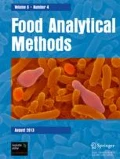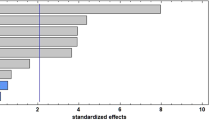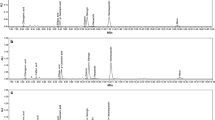Abstract
Mandarin and lime peels are rich sources of phenolic compounds including phenolic acids and flavonoids. The ultrasound-assisted extraction (UAE) proved to be an effective method in the extraction of phenolic compounds from plants due to its ability to save extraction time and increase extraction yields. In this research, factorial randomized complete experimental design has been used to investigate the effect of various factors on UAE using low power (50.93 W). Influence of citrus peel types and solvent types and concentrations on the total phenolic compounds, total flavonoids, and flavanone glycosides (hesperidin and naringin) were studied. Antioxidant activity of the extracts was measured by ferric reducing antioxidant potential (FRAP), azino-bis(3-ethylbenzthiazoline-6-sulfonic acid) (ABTS), and 1,1-diphenyl-2-picrylhydrazyl (DPPH) assays. The optimum extraction conditions occurred when mandarin peel and 80 % acetone were used. In those conditions, the extract contained 3,083.61 mg gallic acid equivalent (eq) 100 g−1 dry weight (DW) of total phenolic compounds, 2,539.82 mg quercetin eq 100 g−1 DW of total flavonoid, 1,374.20 mg 100 g−1 DW of hesperidin, and the measured antioxidant activity was 0.61 mg mL−1 of DPPH IC50, 1.12 mg mL−1 of ABTS IC50, and 2,521.47 mg trolox eq 100 g−1for FRAP. A strong correlation between total phenolic content and antioxidant activity was also observed.



Similar content being viewed by others
References
Abeysinghe DC, Li X, Sun C, Zhang W, Zhou C, Chen K (2007) Bioactive compounds and antioxidant capacities in different edible tissues of citrus fruit of four species. Food Chem 104:1338–1344. doi:10.1016/j.foodchem.2007.01.047
Anagnostopoulou MA, Kefalas P, Papageorgiou VP, Assimopoulou AN, Boskou D (2006) Radical scavenging activity of various extracts and fractions of sweet orange peel (Citrus sinensis). Food Chem 94:19–25. doi:10.1016/j.foodchem.2004.09.047
Babbar N, Oberoi HS, Uppal DS, Patil RT (2011) Total phenolic content and antioxidant capacity of extracts obtained from six important fruit residues. Food Res Int 44:391–396. doi:10.1016/j.foodres.2010.10.001
Benavente-García O, Castillo J, Marin FR, Ortuño A, Del Río JA (1997) Uses and properties of citrus flavonoids. J Agric Food Chem 45:4505–4515. doi:10.1021/jf970373s
Biesaga M (2011) Influence of extraction methods on stability of flavonoids. J Chromatogr A 1218:2505–2512. doi:10.1016/j.chroma.2011.02.059
Brand-Williams W, Cuvelier ME, Berset C (1995) Use of a free radical method to evaluate antioxidant activity. LWT-Food Sci Technol 28:25–30. doi:10.1016/S0023-6438(95)80008-5
Chemat F, Zille H, Khan MK (2011) Applications of ultrasound in food technology: processing, preservation and extraction. Ultrason Sonochem 18:813–835. doi:10.1016/j.ultsonch.2010.11.023
Gattuso G, Barreca D, Gargiulli C, Leuzzi U, Caristi C (2007) Flavonoid composition of citrus juices. Molecules 12:1641–1673. http://www.mdpi.com/1420-3049/12/8/1641
Gorinstein S, Martı́n-Belloso O, Park YS, Haruenkit R, Lojek A, Ĉı́ž M, Caspi A, Libman I, Trakhtenberg S (2001) Comparison of some biochemical characteristics of different citrus fruits. Food Chem 74:309–315. doi:10.1016/S0308-8146(01)00157-1
Guha G, Rajkumar V, Ashok Kumar R, Mathew L (2010) Aqueous extract of Phyllanthus amarus inhibits chromium(VI)-induced toxicity in MDA-MB-435S cells. Food Chem Toxicol 48:396–401. doi:10.1016/j.fct.2009.10.028
Guimarães R, Barros L, Barreira JCM, Sousa MJ, Carvalho AM, Ferreira ICFR (2010) Targeting excessive free radicals with peels and juices of citrus fruits: Grapefruit, lemon, lime and orange. Food Chem Toxicol 48:99–106. doi:10.1016/j.fct.2009.09.022
Hemwimol S, Pavasant P, Shotipruk A (2006) Ultrasound-assisted extraction of anthraquinones from roots of Morinda citrifolia. Ultrason Sonochem 13:543–548. doi:10.1016/j.ultsonch.2005.09.009
Huang D, Ou B, Prior RL (2005) The Chemistry behind antioxidant capacity assays. J Agric Food Chem 53:1841–1856. doi:10.1021/jf030723c
Jayaprakasha GK, Girennavar B, Patil BS (2008) Antioxidant capacity of pummelo and navel oranges: extraction efficiency of solvents in sequence. LWT-Food Sci Technol 41:376–384. doi:10.1016/j.lwt.2007.03.017
Khan MK, Abert-Vian M, Fabiano-Tixier AS, Dangles O, Chemat F (2010) Ultrasound-assisted extraction of polyphenols (flavanone glycosides) from orange (Citrus sinensis L.) peel. Food Chem 119:851–858. doi:10.1016/j.foodchem.2009.08.046
Li Y, Fabiano-Tixier AS, Tomao V, Cravotto G, Chemat F (2013) Green ultrasound-assisted extraction of carotenoids based on the bio-refinery concept using sunflower oil as an alternative solvent. Ultrason Sonochem 20:12–18. doi:10.1016/j.ultsonch.2012.07.005
Londoño-Londoño J, Lima VRD, Lara O, Gil A, Pasa TBC, Arango GJ, Pineda JRR (2010) Clean recovery of antioxidant flavonoids from citrus peel: optimizing an aqueous ultrasound-assisted extraction method. Food Chem 119:81–87. doi:10.1016/j.foodchem.2009.05.075
Ma Y, Ye X, Hao Y, Xu G, Xu G, Liu D (2008a) Ultrasound-assisted extraction of hesperidin from Penggan (Citrus reticulata) peel. Ultrason Sonochem 15:227–232. doi:10.1016/j.ultsonch.2007.03.006
Ma YQ, Chen JC, Liu DH, Ye XQ (2008b) Effect of ultrasonic treatment on the total phenolic and antioxidant activity of extracts from citrus peel. J Food Sci 73:T115–T120. doi:10.1111/j.1750-3841.2008.00908.x
Ma Y-Q, Chen J-C, Liu D-H, Ye X-Q (2009) Simultaneous extraction of phenolic compounds of citrus peel extracts: effect of ultrasound. Ultrason Sonochem 16:57–62. doi:10.1016/j.ultsonch.2008.04.012
Makovšek K, Knez Ž, Škerget M (2012) Influence of process parameters on the extraction of flavanones from mandarin peel. Acta ChimSlov 59:879–887. http://eds.b.ebscohost.com/ehost/pdfviewer/pdfviewer?sid=73d53e7a-c6c8-4c48-adf5-220b34eda980%40sessionmgr115&vid=2&hid=101
Musa K, Abdullah A, Jusoh K, Subramaniam V (2011) Antioxidant activity of pink-flesh guava (Psidium guajava L.): effect of extraction techniques and solvents. Food Anal Methods 4:100–107. doi:10.1007/s12161-010-9139-3
Oboh G, Ademosun AO (2012) Characterization of the antioxidant properties of phenolic extracts from some citrus peels. J Food Sci Technol 49:729–736. doi:10.1007/s13197-010-0222-y
Office of Agricultural Economics (2013) Agricultural production data. Mandarin. http://www.oae.go.th/ewt_news.php?nid=13577. Acessed 29 Jan 2013
Peterson JJ, Beecher GR, Bhagwat SA, Dwyer JT, Gebhardt SE, Haytowitz DB, Holden JM (2006) Flavanones in grapefruit, lemons, and limes: a compilation and review of the data from the analytical literature. J Food Compos Anal 19, Supplement:S74-S80 doi:10.1016/j.jfca.2005.12.009
Prior RL, Wu X, Schaich K (2005) Standardized methods for the determination of antioxidant capacity and phenolics in foods and dietary supplements. J Agric Food Chem 53:4290–4302. doi:10.1021/jf0502698
Procházková D, Boušová I, Wilhelmová N (2011) Antioxidant and prooxidant properties of flavonoids. Fitoterapia 82:513–523. doi:10.1016/j.fitote.2011.01.018
Ramful D, Bahorun T, Bourdon E, Tarnus E, Aruoma OI (2010) Bioactive phenolics and antioxidant propensity of flavedo extracts of Mauritian citrus fruits: potential prophylactic ingredients for functional foods application. Toxicology 278:75–87. doi:10.1016/j.tox.2010.01.012
Su M-S, Shyu Y-T, Chien P-J (2008) Antioxidant activities of citrus herbal product extracts. Food Chem 111:892–896. doi:10.1016/j.foodchem.2008.05.002
Thitima K, Sakamon D, Naphaporn C (2009) Evolution of antioxidant compounds in lime residues during drying. Food Chem 113:944–949. doi:10.1016/j.foodchem.2008.08.026
Tripoli E, Guardia ML, Giammanco S, Majo DD, Giammanco M (2007) Citrus flavonoids: molecular structure, biological activity and nutritional properties—a review. Food Chem 104:466–479. doi:10.1016/j.foodchem.2006.11.054
United States Department of Agricultural Service (2014) Citrus: world markets and trade. http://usda.mannlib.cornell.edu/MannUsda/viewDocumentInfo.do?documentID=1774. Acessed 8 Apr 2014
Wang YC, Chuang YC, Hsu HW (2008) The flavonoid, carotenoid and pectin content in peels of citrus cultivated in Taiwan. Food Chem 106:277–284. doi:10.1016/j.foodchem.2007.05.086
Wijekoon MMJO, Bhat R, Karim AA (2011) Effect of extraction solvents on the phenolic compounds and antioxidant activities of bunga kantan (Etlingera elatior Jack.) inflorescence. J Food Compos Anal 24:615–619. doi:10.1016/j.jfca.2010.09.018
Ziaur R (2006) Citrus peel extract—a natural source of antioxidant. Food Chem 99:450–454. doi:10.1016/j.foodchem.2005.07.054
Conflict of Interest
Riantong Singanusong has no conflict of interest. Suriyaporn Nipornram has no conflict of interest. Worasit Tochampa has no conflict of interest. Puntarika Rattanatraiwong has no conflict of interest. This article does not contain any studies with human or animal subjects.
Author information
Authors and Affiliations
Corresponding author
Rights and permissions
About this article
Cite this article
Singanusong, R., Nipornram, S., Tochampa, W. et al. Low Power Ultrasound-Assisted Extraction of Phenolic Compounds from Mandarin (Citrus reticulata Blanco cv. Sainampueng) and Lime (Citrus aurantifolia) Peels and the Antioxidant. Food Anal. Methods 8, 1112–1123 (2015). https://doi.org/10.1007/s12161-014-9992-6
Received:
Accepted:
Published:
Issue Date:
DOI: https://doi.org/10.1007/s12161-014-9992-6




